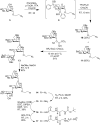A bivalent glycopeptide to target two putative carbohydrate binding sites on FimH
- PMID: 20978621
- PMCID: PMC2956480
- DOI: 10.3762/bjoc.6.90
A bivalent glycopeptide to target two putative carbohydrate binding sites on FimH
Abstract
FimH is a mannose-specific bacterial lectin found on type 1 fimbriae with a monovalent carbohydrate recognition domain (CRD) that is known from X-ray studies. However, binding studies with multivalent ligands have suggested an additional carbohydrate-binding site on this protein. In order to prove this hypothesis, a bivalent glycopeptide ligand with the capacity to bridge two putative carbohydrate binding sites on FimH was designed and synthesized. Anti-adhesion assays with the new bivalent ligand and type 1-fimbriated bacteria have revealed, that verification of the number of carbohydrate binding sites on FimH with a tailor-made bivalent glycopeptide requires further investigation to be conclusive.
Keywords: ELISA; FimH; bacterial adhesion; bivalent ligand; glycopeptides.
Figures





References
-
- Klemm P, Schembri M. Int J Med Microbiol. 2000;290:27–35. - PubMed
LinkOut - more resources
Full Text Sources
Other Literature Sources
